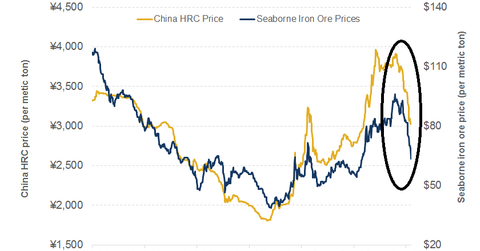Why US Steel Bears Could Have a Valid Point
US steel prices have held their ground in 2017 and have built on last year’s gains. However, the bears (SDS) also have some valid points. Let’s discuss them in perspective.
May 8 2017, Updated 9:05 a.m. ET

US steel bears
Earlier, we looked at the bullish drivers of US steel prices. To sum it up, low supply chain inventory, strong demand, stable scrap prices, and expectations of protectionist trade policies have been supporting US steel prices this year.
US steel prices have also held their ground in 2017 and have built on last year’s gains. However, the bears (SDS) also have some valid points. Let’s discuss them in perspective.
Bearish argument
Steel bears point to falling seaborne iron ore prices as bearish drivers for steelmakers such as U.S. Steel Corporation (X), Nucor (NUE), and ArcelorMittal (MT). While lower steel prices could dent the profitabilities of steel companies’ iron ore mining operations, they could also impact scrap pricing.
Imports of blooms, billets, and slabs rose 77% year-over-year (or YoY) in March to 795,000 metric tons. Note that ingots, slabs, blooms, and billets are all semifinished steel products. These products have to be worked on more before end consumers can use them.
Higher imports of such products suggest that US steel mills could be looking to use alternate raw materials as steel scrap prices remain elevated. If we see a fall in steel scrap prices, it could have a negative impact on US steel prices also.
Some market observers expect a further fall in Chinese steel prices this year, which could lead to lower steel prices globally.
Steel bears point to widening spreads between US and international steel prices as a risk for US steelmakers. Notably, higher spreads make imports attractive and could potentially spur steel imports (AKS).
So far in this series, we’ve looked at steel’s bearish and bullish drivers. Continue to the next article for our concluding remarks.
